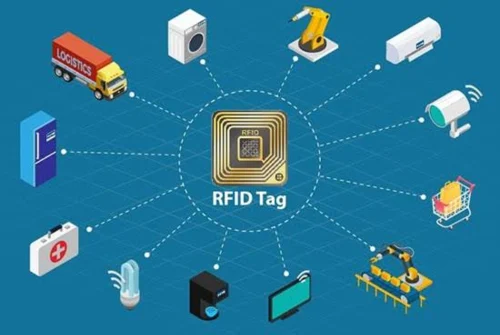Radio Frequency Identification (RFID) is an advanced technology with a significant impact on various industries. While many are familiar with its basic use in inventory tracking, there are numerous lesser-known aspects of RFID that showcase its versatility and innovation. Let’s learn some fascinating facts about this technology.
1. RFID and the Internet of Things (IoT)
RFID is an important part of the Internet of Things (IoT), where devices are connected to make life easier and more efficient. In farming, RFID tags are used to check soil conditions, keep track of animal movements, and monitor crop health, helping farmers plan better. In transportation, RFID tags on packages give live updates about their location and condition, ensuring goods are delivered safely. In shops, RFID makes it easier to manage stock and offers personalized services to customers. These examples show how RFID helps industries work smarter and faster.
2. The Origin of RFID: A Spy Gadget :
The story of RFID’s origins is as fascinating as the technology itself. In 1945, Soviet inventor and spy Leon Theremin created a device called "The Thing" to help the Soviet government eavesdrop on the U.S. Ambassador in Moscow. This device was cleverly hidden inside a wooden plaque and gifted as a diplomatic token. What made "The Thing" special was its ability to capture sound and transmit it using radio waves whenever a beam of radio frequency energy activated it.
Although "The Thing" wasn’t an RFID device as we know today, it introduced the principle of passive radio-frequency-powered communication. Decades later, this concept evolved into RFID technology, which uses radio waves to identify and track objects, animals, or even people without relying on an internal power source in the tag. Leon Theremin’s invention laid the foundation for developing wireless identification systems, influencing the way RFID technology works today
3. Edible RFID Tags for Food Safety :
RFID technology is not just confined to plastic or metal tags anymore; it has evolved to include edible tags that improve food safety and transparency. These innovative RFID tags are created using food-grade materials, making them safe for consumption. Their primary purpose is to provide critical information about the food item they are attached to, such as its origin, manufacturing date, storage conditions, and even its nutritional value.
For example, For Fresh produces like Milk, Vegetables and Fruits, edible RFID tags can ensure that the cold chain is maintained during transportation, confirming that the product has remained fresh until it reaches the consumer.
This innovation is still in its early stages but has the potential it has in the food industry, offeri consumers a new level of confidence and clarity about the products they consume
4. Smallest RFID Chip: The Size of a Grain of Rice :
The smallest RFID chip in the world measures just 0.1 inches square, approximately the size of a grain of rice. Despite its minuscule dimensions, this tiny chip is incredibly versatile and capable of a wide range of applications. It is commonly used in ecological research, such as in tracking bees to study their behaviour and migration patterns, which is crucial for understanding environmental changes and pollination. Additionally, its small size and durability make it ideal for monitoring shipments in harsh conditions, where traditional tracking devices might be too large or vulnerable.
5. RFID in the Vatican Library :
One of the most fascinating applications of RFID technology is in the Vatican Library, home to over two million manuscripts, some dating back centuries. These texts are irreplaceable treasures, holding immense historical, cultural, and religious significance. Managing such a vast and valuable collection used to be a tedious process, often taking weeks or even months to complete inventories and locate specific items.
With RFID, the process has been changed. Each manuscript is tagged with a unique RFID chip, allowing staff to track its exact location within seconds. This technology not only speeds up inventory management, reducing weeks of work to a matter of hours, but also ensures the security of these precious documents. RFID gates and sensors monitor movements in and out of storage areas, minimizing the risk of theft or misplacement. Moreover, RFID helps in maintaining optimal storage conditions. Sensors can be paired with RFID systems to monitor temperature and humidity levels, ensuring that these fragile texts remain preserved for future generations.
6. RFID and Driverless Cars :
RFID technology plays a critical role in the development and operation of autonomous vehicles( Eg. Driverless cars) by allowing precise communication and integration with infrastructure. RFID tags are strategically embedded in traffic signs, road surfaces, and even vehicles to transmit critical information to onboard sensors. This allows driverless cars to navigate accurately, adapt to real-time conditions, and ensure safer operations.
For example, RFID tags in traffic lights can communicate signal changes to autonomous vehicles( which has RFID Readers ), reducing accidents at intersections. Similarly, RFID-enabled toll systems allow contactless toll collection. In parking spaces, RFID tags identify available spaces, guiding vehicles directly to them, saving time and energy.
The use of RFID increases vehicle-to-infrastructure (V2I) connectivity, forming a foundational layer for smart transportation systems. It improves navigation and safety
7. Waste Management with RFID :
Cities are adopting RFID technology to improve waste management by integrating it with other sensors. Smart bins are equipped with sensors, like ultrasonic or infrared, that monitor the fill levels of the bins. These sensors measure the distance between the sensor and the top of the waste, determining how full the bin is.
The RFID tag attached to each bin holds a unique identifier. When the sensor detects the fill level, it sends this information, along with the RFID tag data, to a centralized waste management system. This system can then track which bins are full and plan collection routes, reducing unnecessary trips, saving fuel, and preventing overflows.
By using RFID alongside other sensors, cities can make waste management more efficient, cleaner, and environmentally friendly, paving the way for smarter, greener urban spaces.
8. RFID for Livestock Management and Healthcare Applications :
RFID technology plays a crucial role in improving livestock management. By attaching RFID tags to animals, farmers can track each animal's health, movements, and even breeding cycles. This helps in better herd management, early detection of diseases, and ensures timely vaccinations and treatments, ultimately reducing the spread of diseases and improving the overall health of the animals. RFID also supports record-keeping, making it easier to manage large herds.
In healthcare, RFID is used to track medical equipment and ensure patient safety. By tagging equipment, hospitals can easily locate tools, reducing the time spent searching for them. Additionally, RFID systems help track medications, it sees that the right drug is administered to the right patient at the right time. RFID also supports accurate inventory management, preventing shortages of critical medical supplies.
9. RFID tags are used for WildLife Conservation :
Researchers and conservationists use RFID tags to track animals, monitor their movements, and study their behaviour in the wild. For example, RFID tags are attached to endangered species like sea turtles and Rhinos to track their activities, breeding sites, and overall health. This data is crucial for creating conservation strategies and protecting vulnerable species. RFID is also used to prevent poaching by monitoring the movement of wildlife through RFID-enabled collars or tags, ensuring that conservationists can act quickly if any animals are in danger
10. Chipless RFID: Reducing Costs :
A recent breakthrough in RFID is the development of chipless RFID tags. These tags use resonators and reflectors instead of silicon chips, reducing manufacturing costs. This innovation makes RFID more accessible for widespread applications, potentially replacing barcodes in the retail sector.

